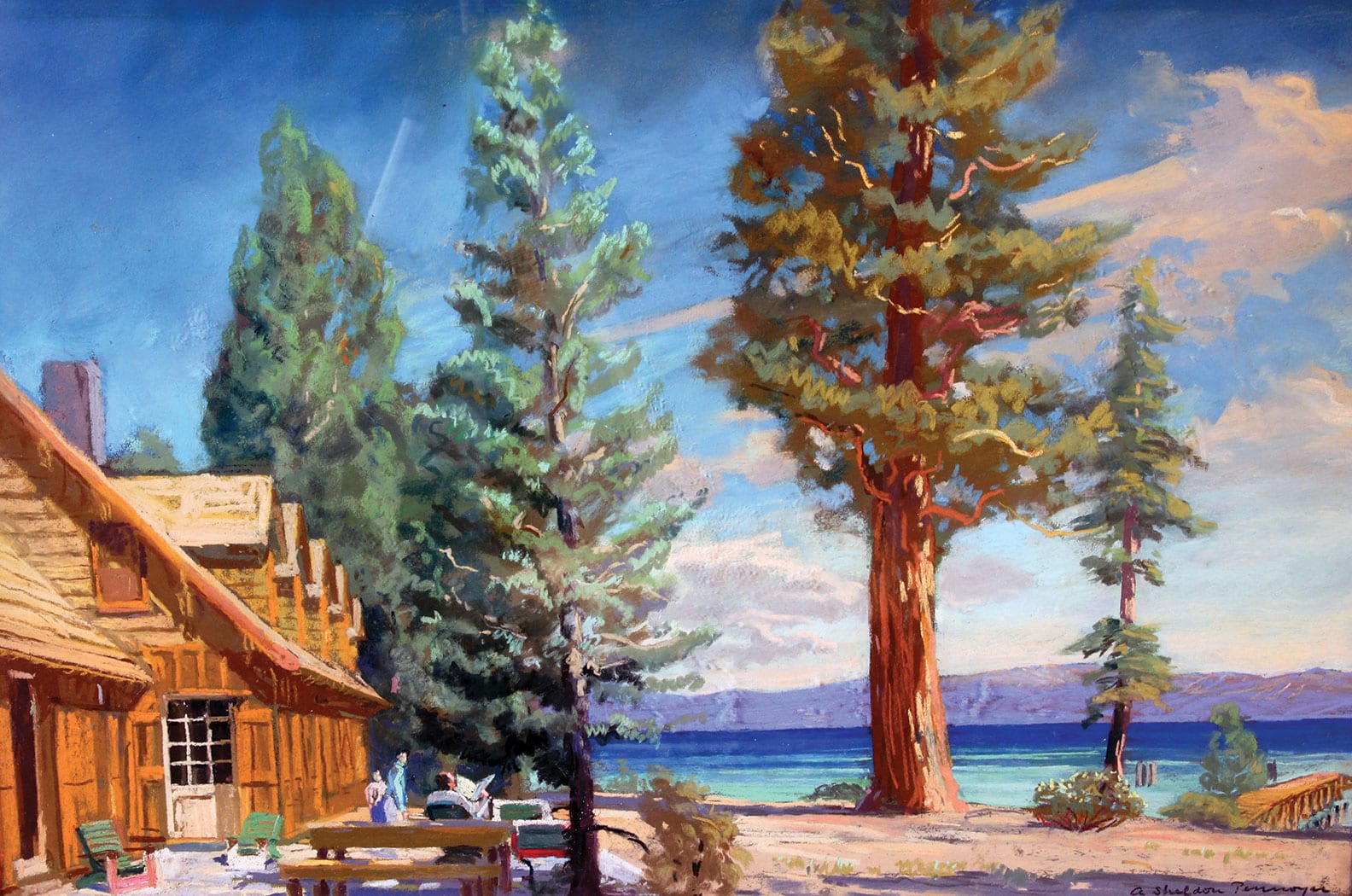
01 May Paradise Reclaimed
Historic West Shore Home could receive a second life as a much-needed cross-country ski lodge
For 75 years, Paradise Flat on the West Shore of Lake Tahoe was a summer home for descendants of spice magnate August Schilling, financier J.P. Morgan and the Pennoyers, who were successful dry goods merchants from Oakland.
But on rare occasions, the family would visit when deep snows blanketed the Rubicon Bay property. On several of those occasions, Sandra (Schilling) Santos recalls arriving late at night and skiing from Highway 89 toward the property over unplowed roads with a knapsack slung over her back. The moon hung overhead lighting the way, and before her the family retreat lit up in a warm yellow glow on the shores of the lake. Someone had gone ahead to light the old locomotive boiler and warm the home. That moment, sliding over snow toward the warm light of the cherished family home, is etched in her memory forever.
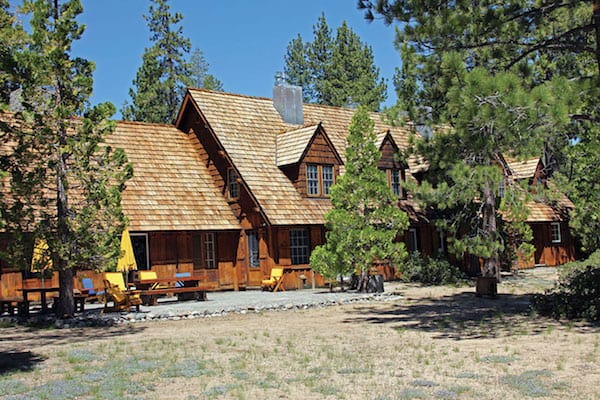
Designed by architect Roland Stringham, the 4,600-square-foot home features steep roof pitches, dormer windows and cedar roof shakes, courtesy photo
“I hope other people get to have that experience,” says Santos, the granddaughter of Paul and Frances Pennoyer, who had the home built in 1936.
If a group of dedicated community volunteers succeed, Santos’ wish will come true. In fact, thousands of people could soon enjoy the storied structure so cherished by five generations of the Pennoyer-Schilling family if it is reconstructed as the Schilling Lodge at Tahoe Cross Country Ski Area in Tahoe City.
Since 2016, when the property was carefully deconstructed by Loverde Builders, Paradise Flat’s historic pieces have been stacked in storage, meticulously catalogued and labeled, awaiting their second life. If Paradise Flat does become the Schilling Lodge, it will be a remarkable resurrection for one of Tahoe’s unique, history-filled structures—a transformation of a home once reserved for generations of family enjoyment, now opened as a gathering place for the greater Tahoe community.
“I really believe this will put Tahoe City and Tahoe Cross Country on the map in a big way,” says Jim Robins, president of the North Shore ski resort. “And it can be the glue that will hold this community together.”
How one of Tahoe’s last remaining intact 1930s homes came to be donated to a small nonprofit is a story of Tahoe’s past, present and future, and the generations of colorful Tahoe homeowners who have fallen under the sway of the lake’s spellbinding magic. It is the story of people dedicated to preserving the past, while forging ahead into the future. The ongoing saga of Paradise Flat is, in many ways, the story of the last century of Lake Tahoe history.
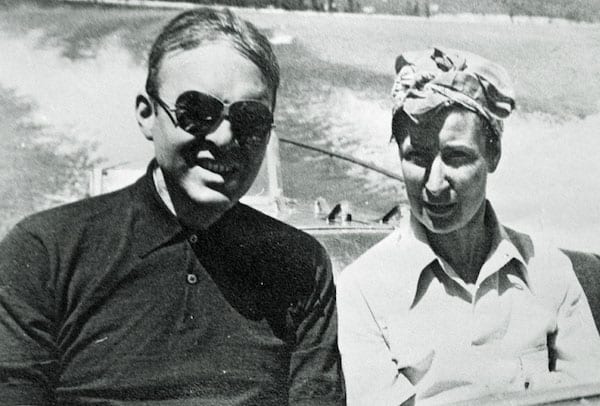
Paul and Frances Pennoyer enjoy a boat ride during their first summer at Paradise Flat, courtesy photo
A Ruby for Real Estate
How Paul and Frances Pennoyer purchased lakefront property at Lake Tahoe in 1936 is a pre-World War II rendition of the now-familiar Tahoe maxim, “I came to Tahoe for one winter and decades later I am still here”—a refrain heard frequently around bartops and coffee shop counters throughout the region.
The Pennoyers were on a simple family vacation in 1936, when Lake Tahoe’s beauty cast its unbreakable spell. With six children in tow, Paul, the son of successful dry goods merchants in Oakland, and Frances, the daughter of financial giant J.P. Morgan, traveled to Tahoe to revisit the natural wonders that had captivated Paul as a child, and return to the site of their 1917 honeymoon.
In 1936, Tahoe was in transition. Landmark homes were being built around its shores, including the Thunderbird Lodge, which began construction that year. But skiing had not yet come to the region in force. It would be nearly three years until Sugar Bowl skiers would load onto the first chairlift in California and another decade until Squaw Valley would open its lifts.

Supper on the beach in 1939, courtesy photo
The Pennoyers quickly fell in love with the rugged and secluded beauty of the lake. After visiting Emerald Bay and staying near Cascade Lake, they were invited to visit Paul’s childhood friend, banker Howard Fletcher, at his Rubicon Bay home. The families instantly connected, and Fletcher noted that a neighboring property, once the site of Rubicon Park Lodge, was for sale.
“That afternoon they bought the property on a handshake,” says Santos.
But while the handshake sealed the deal, the couple still had to finalize the transaction. They met with architect Roland Stringham in Sacramento on their way back to the East Coast and discussed the design of the summer home. Upon returning to their New York home, they decided how to pay for their dream.
Frances took a ruby pendant, a gift from her late mother, and sold it to her younger brother Henry S. “Harry” Morgan, who would go on to be a founding partner of Morgan Stanley. Morgan gave the pendant to his wife as a gift. In that way the jewelry stayed within the family and the Pennoyers gained their own treasure—a summer home on the Jewel of the Sierra.
Work began immediately on the property. Stringham’s design, with its steep roof pitches, dormer windows, sturdy pine siding and cedar roof shakes, was crafted to stand up to the severe mountain weather. The great room, which would become the gathering place for five generations of the family, was a focal point of the 4,600-square-foot home, with vaulted ceilings and exposed scissor trusses. The stepped, fieldstone chimney anchors the home to the back patio.

The old locomotive boiler used to heat the home has since been donated to the Truckee Railroad Museum, courtesy photo
A Monument Man Paints Paradise
In the final stages of construction, Paul’s brother, A. Sheldon Pennoyer, traveled to the property to oversee the final details and furnishings. He indulged his and his brother’s passion for locomotives by outfitting the home with carefully selected railroad-themed accessories.
Sheldon was a masterful painter who had served in the camouflage unit of the Army Corps of Engineers during World War I. Not long after helping complete the construction of Paradise Flat, he was called back into service, this time to rescue some of the world’s greatest art pieces from destruction by the Nazis during World War II as a member of the famous Monument Men.
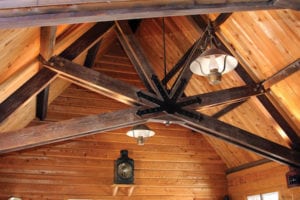
Exposed scissor trusses are among the architectural features of the interior, courtesy photo
Into the 1950s, Sheldon was the beloved “bachelor uncle” of Paradise Flat, says Santos, constantly painting beautiful Tahoe landscapes on the patio or down by the shoreline.
“My mother told me that he loved being there because the light in summer was like no other,” says Santos.
Today, A. Sheldon Pennoyer’s paintings can be found in renowned displays in museums across the nation, and Princeton University exhibits his stunning Monument Men photos, where he captured the aftermath of World War II and the effort to preserve some of the world’s most profound artistic and cultural heritage throughout bomb-scarred Italy.
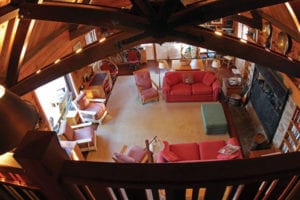
The spacious great room of the home from above, courtesy photo
By the early summer of 1937, Paradise Flat was complete and ready to receive the Pennoyers. They came by transcontinental rail in the Pullman railcars of “The Forty Niner” on the train’s second transcontinental run.
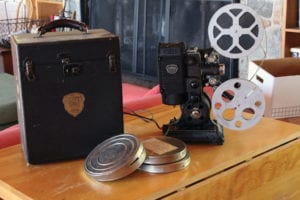
The projector that played Felix the Cat on the family’s movie nights, courtesy photo
That first summer was the start of 75 years of tradition—large family lunches on the patio, swimming in the crystalline waters of Lake Tahoe and adventures in the mountains above the lake. The family spent their summers outside, playing until exhaustion set in. And when the long summer days came to a close, they’d settle down with a good book, conversation or, on some occasions, Felix the Cat movies played on the movie projector.
“It seems that whenever we were there our lives were vivid, vibrant and brimming with the antics of a boisterous family enjoying abundant natural beauty,” says Santos of the ensuing years when those same family traditions were kept.
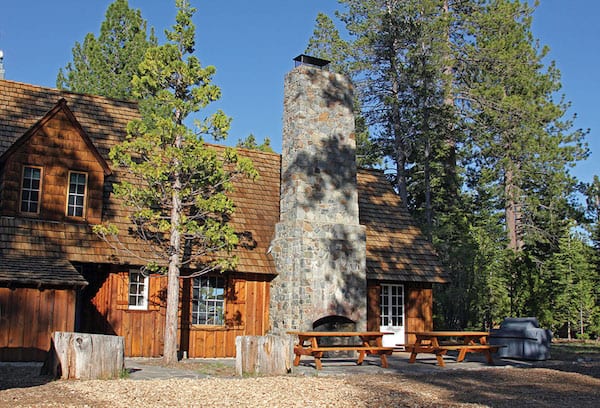
A large exterior fireplace was built from locally sourced granite, courtesy photo
Simple Yet Storied
Decades passed with the Pennoyers traveling to the home each year for summer-long vacations. And as the years rolled by Paradise Flat remained the same, while Lake Tahoe began to slowly change around it. Neighboring homes changed hands, were torn down or remodeled. Slowly Paradise Flat began to stand out as a reminder of a bygone era and an enduring remnant of the Old Tahoe lifestyle.
Two Sicilian donkeys trotted around the property—Clementine and Concertina—and were even known to nap on the beach in the afternoon. Santos remembers the Kingfisher tour boat from Tahoe City motoring by laden with tourists gazing at the homes along Rubicon Bay, and hearing the boat’s captain announcing: “Here is the Old Schilling house built by the spice empire, and it has a full-sized locomotive in the living room.” The allusion to Sheldon’s treasured railroad artifacts that adorned the home had been spun into a full-blown fantasy that surely captivated the minds of the boat passengers.
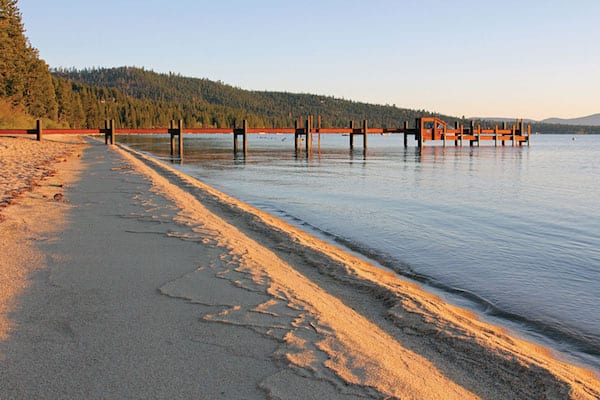
Paradise Flat’s prime beachfront in Rubicon Bay, courtesy photo
“That is how rumors get started,” says Santos.
But changes did come to Paradise Flat, even as the home stayed the same. The full property, including nearly 800 feet of lakefront and just over 21 acres, was eventually split between members of the Pennoyer family. Still, the family kept the home the same, preserving what was becoming an increasingly rare example of 1930s Tahoe.
“I think what people loved about our home was it retained all the old features and looked exactly the way it always did, and it jogged people’s memories,” says Santos.
The same hand-forged door latches, locomotive boiler and even some fixtures retained the history and memories that had accumulated in the home.
Paradise Flat was passed on to Frances Tracy Schilling, Santos’ mother, and they continued to open and manage the home with the help of a talented team of Tahoe caretakers.
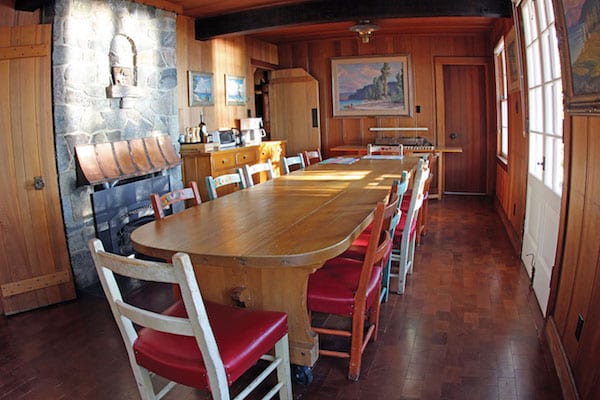
Many a meal was served in the cozy dining quarters over the decades, courtesy photo
The End of an Era
As the home aged, the maintenance and upkeep became more and more laborious. The home’s knob-and-tube electrical wiring, state-of-the-art in 1936, became a fire hazard and had to be
replaced. The home’s cedar shingle roof made insurance increasingly hard to come by. Finally, it became clear that passing the home along to future generations of the family was not the right decision.
“It felt like it was going to be more of a burden than a blessing,” says Santos. “We did not make lightly the decision to sell the property.”
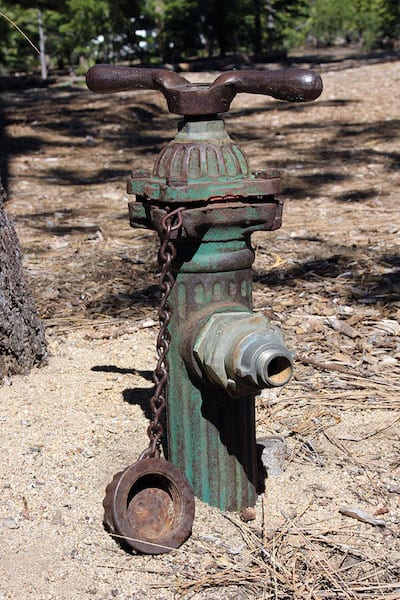
Gravity-fed fire hydrants were the property’s first line of defense in the event of a fire, and were used on occasion to scare away scavenging bears, courtesy photo
When Paradise Flat came onto the market, John Mozart, a renowned Palo Alto developer, happened to be walking to Obexer’s Boat Company in Homewood to grab the morning newspaper and glanced at the listing in the window of the Oliver Luxury Real Estate office.
The West Shore of Tahoe had always held a special place in Mozart’s heart since a seminal camping trip early in his childhood.
“I camped out in the early 1950s in D.L Bliss State Park—the first vacation I remember—and it was the most memorable time of my life,” says Mozart.
Mozart’s parents went on to build a house on the West Shore in the 1960s. And Mozart followed in their footsteps by building his own house in Homewood later in life.
Which brought him to Obexer’s that morning. Mozart couldn’t resist the opportunity to own a lakefront near the D.L. Bliss beaches that had so captivated him as a child, so he purchased Paradise Flat in 2012. And then, when the neighboring property came on the market—the Julia Morgan–designed Bow Bay home (commissioned by another Schilling family member, Else Schilling)—he bought that as well.
On the Paradise Flat property, he planned a new home inspired by the architectural heritage of Lake Tahoe, which is now nearing completion.
“You look at it and think it was built in the 1920s,” says Mozart, who also meticulously restored Bow Bay, which is widely recognized as an architectural treasure because of the Julia Morgan design.
“John has a unique appreciation for history,” says Wyatt Ogilvy, a land use consultant who worked with Mozart on the project. “Their attention to detail and the craft of their home is highly unique and rare.”
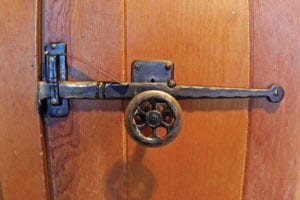
One of the home’s hand-forged brass door handles, courtesy photo
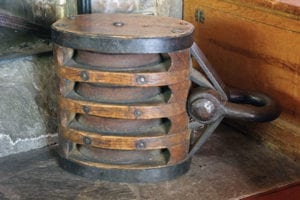
A pulley from a sailboat is one of many historic items used to decorate the home, courtesy photo
Mozart also went to great lengths to preserve the original Paradise Flat home, and eventually found the perfect recipient of the historic structure in the Tahoe Cross Country Ski Education Association. In addition to donating the building, he contributed a generous donation to fund the deconstruction of the building, and kickstart the design and the reconstruction of the building.
In 2015, the Schilling home came down piece by piece, board by board, more than three quarters of a century after it had been built on a sparsely populated West Shore.
It was the start of the project that was both ambitious and one-of-a-kind.
“I’ve been at this for 20 years in the Tahoe Basin, and I have never worked on a project as unique as this,” says Ogilvy.
Tahoe Cross Country
The need for the “Schilling Lodge,” as the Tahoe Cross Country project is being called, is apparent as soon as you pull up to the ski resort. The parking lot only holds 44 spaces. On busy days, cars spill out into a tangle of surrounding neighborhood streets. And the “lodge” is actually a 1970s golf course clubhouse.
While the staff has valiantly used every square inch available and retrofitted the building with wood slabs and rustic touches that give it a ski resort vibe, the cross-country center is clearly bursting at the building’s seams.

The lodge at Tahoe Cross Country was used as a golf course clubhouse in the 1970s, courtesy photo
“It’s chaos,” says Ben Grasseschi, executive director of the resort, of the building on busy days. “But it seems to work.”
Except, on some days and for some programs, despite Grasseschi putting a brave face on it, it clearly doesn’t work. A metal shipping container holds overflow items alongside the lodge, child ski carriers sit alongside lodge chairs because there is nowhere else for them to go, and the rental room is so small that people literally back up or bump into each other as they pile in for rentals in the morning.
And there are other problems with the location.
“I just want to do lessons where it is flat,” says Tim Hauserman, a longtime youth instructor at the resort.
For a novice, the abrupt hill right out of the rental shop is a tough place to be introduced to the joys of skinny skis with no edges.
“Eighty percent of our customers are beginners, and this hill out here is pretty intimidating,” says Grasseschi.
The Schilling Lodge would fix all this if it is approved at a potential new location alongside North Tahoe High School, which abuts the ski resort. The higher elevation, flatter terrain and additional parking seem to solve some of the most daunting constraints of the current location.
Right now the lodge proposal is undergoing environmental review and site selection, headed up by the Tahoe City Public Utility District. The process is public, and some neighbors have expressed concerns about traffic and the project’s size publicly. Robins says those concerns will be addressed.
“There are good people who have good questions and they are going to get good answers,” says Robins.
Still, the opposition mystifies some supporters who see a clear opportunity to convert a historic home into a much-needed lodge for a nonprofit that gives away free skiing to anyone under 18 and over 70, and hosts many other education programs.
“There is a lot of potential here. If everyone would look at the big picture and see what this lodge could do for the community, they might see the light,” says Grasseschi.
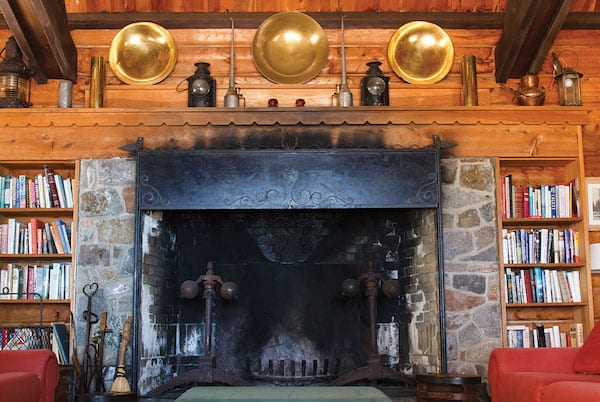
A large fireplace in the great room is flanked by built-in shelving and topped with miscellaneous railroad artifacts and brass opium bowls, courtesy photo
It will be a couple years at the earliest before the Schilling Lodge becomes a reality. And there is much work to be done before then, including public outreach, fundraising and project details. When the pieces of Paradise Flat are pulled out of storage and stitched back together, the lodge would retain the original home’s design, siding, interior trusses and timber. But things like the cedar shake roof—problematic in wildfire country—and the interior layout of the building would be modified to fit the needs of the ski lodge. And an additional 3,000 square feet would be added to the historic structure to make room for storage, rental gear, showers, a first aid station and all the other elements of a fully equipped ski lodge.
“Our intent is to have the building be as welcoming and green as possible,” says Don Heapes, board member of the Tahoe Cross Country Ski Education Association.
Although there is still much work to be done, the thought of a small, volunteer-fueled nonprofit realizing such a dream, and preserving an iconic part of Tahoe’s past for generations of skiers to enjoy, is what animates volunteers like Heapes.
“Preserving a historic residence from an earlier era and giving it a bright second life at the heart of our community is a more than an unique opportunity—it is a blessing our community-based nonprofit intends to honor,” says Heapes.
And those who have waited for years to see this project become reality can’t help but look ahead to the next chapter of a structure that has already seen its fair share of Tahoe’s history.
“I am just thrilled that this house is being returned to the community,” says Santos. “I hope I get to see it. I can’t wait for that day.”
David Bunker is a Truckee-based writer and editor.




Debbie White
Posted at 12:02h, 19 MayThe flip side of this article is the major concerns of the proposed new location next to the high school. Safety, circulation and environmental impact are at the top of the list and anyone involved in this project will know that Modified Site A option (existing TXC site) proposes 100 parking spaces, which is exactly the SAME number of parking spaces proposed in the new site by the high school. The difference in elevation is 76 feet from existing site to proposed new site, which is not significant. For beginner XC skiers, it is a great deal easier to go uphill than downhill. However, the sooner beginners learn to master these skills the better skiers they will become. It is not just about skiing on the flat. For all those lovers of the great outdoors that Tahoe has to offer, rest assured the new location and positioning of the Schilling Lodge will tear up yet more of our beloved environment to make way for a large parking lot and positioning the lodge. With careful planning, lower spend, no environmental impact or safety issues, the Schilling Lodge can take pride of place on the existing TXC lot that will also include renovation of the current building plus the extra parking spaces to make it 100 (same as new site proposal).
Carol Guida
Posted at 18:40h, 28 MayPerhaps Mark Zuckerberg should consider saving the buildings on the two properties he just purchased as this family did (if he decides to rebuild as most people seem to do these days). I am hoping that more of Tahoe’s historic buildings can be saved in this manner so that future generations can see how beautiful Lake Tahoe architecture once was.